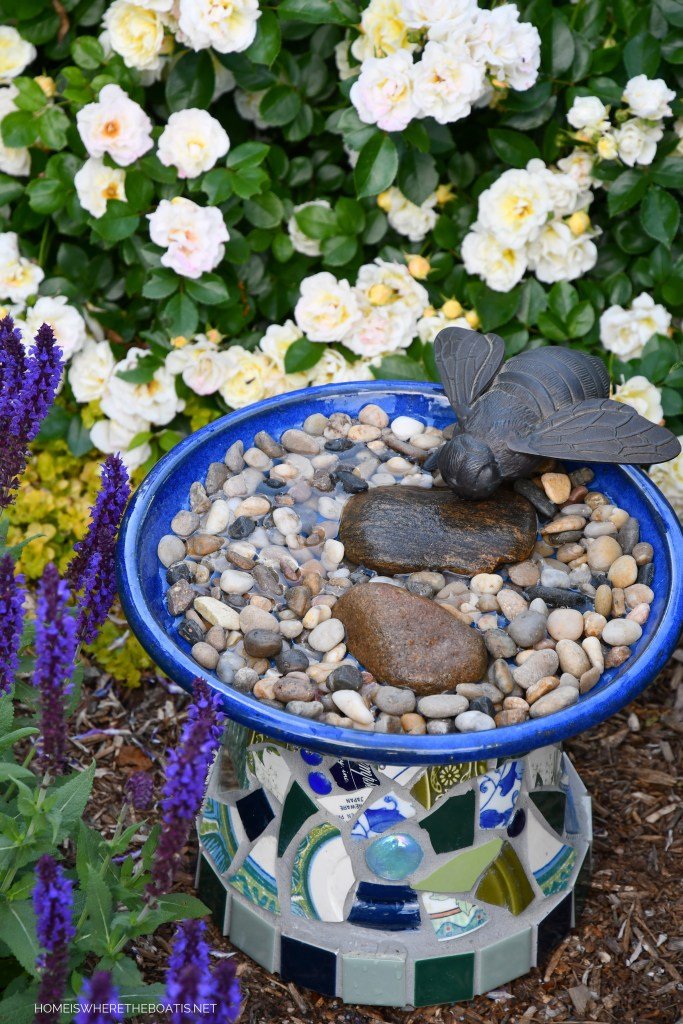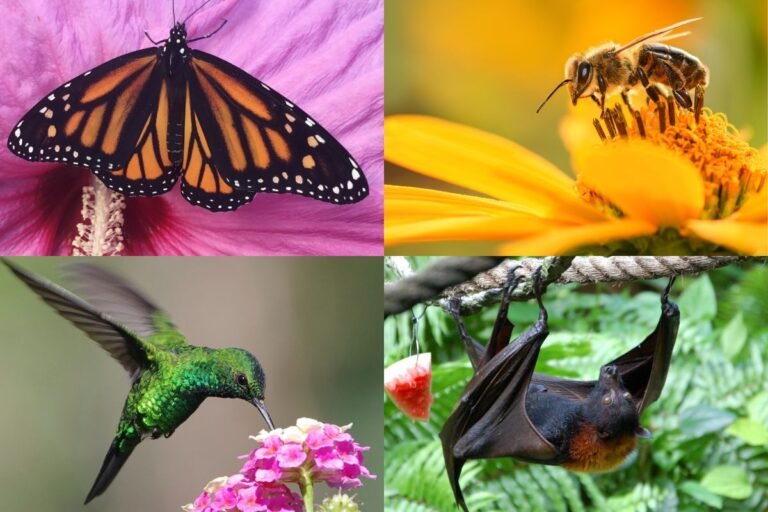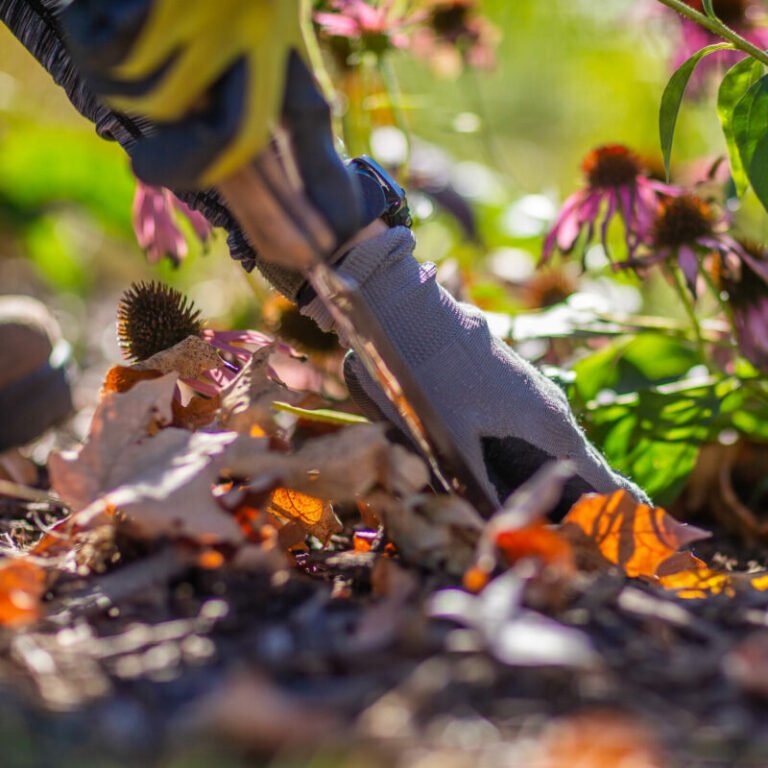Pollinators need water just as much as they need flowers. A water dish can help them thrive in your garden.
Building a simple pollinator water dish is an easy yet vital way to support local wildlife. These small creatures, like bees and butterflies, play a huge role in the environment. They help plants grow, breed, and produce food. By creating a watering spot, you give these helpful insects a place to hydrate.
This guide will show you how to make a safe and inviting water dish. You’ll learn to use materials you might already have at home. This project is not only helpful to pollinators but also fun and educational for all ages. Let’s start crafting a haven for our buzzing friends right in your backyard.
Introduction To Pollinator Water Dishes
Welcome to the world of pollinator water dishes. These simple tools are a gardener’s ally. They support the creatures that keep plants thriving. A pollinator water dish is more than just a bowl of water. It’s a lifeline for bees, butterflies, and other pollinators. Let’s dive into what makes these water sources so vital.
The Importance Of Hydration For Pollinators
Pollinators need water just like we do. It’s essential for their survival. They use it to drink, cool down, and even in some parts of their honey-making process. Without enough water, they can’t do their important work.
Benefits Of Providing A Water Source
- Attracts more pollinators to your garden
- Helps local pollinator populations stay healthy and strong
- Increases the number of flowers and crops that get pollinated

Choosing The Right Location
Bees, butterflies, and other pollinators need water just like we do. Crafting a pollinator water dish is a small step with big impact. Choosing the right location is key for these tiny visitors. Let’s dive into how to select the perfect spot.
Accessibility For Pollinators
A spot easy to find and reach by pollinators works best. Place the dish near flowers or plants. This way, pollinators spot it while gathering nectar. Make sure the landing spots are clear. Avoid tall grass or dense plants nearby.
Safety From Predators
Keep the dish away from areas where predators like birds and cats lurk. A quiet spot reduces risk for tiny pollinators. It’s best to place the dish higher up, like on a table or a wall, away from ground threats.
Sun And Shade Considerations
Balance is important. Too much sun and the water dries up. Too much shade and pollinators may miss it. Aim for a spot with morning sun and afternoon shade. This keeps the water fresh longer and visible to friends with wings.
Selecting A Suitable Container
Selecting the right container for a pollinator water dish is crucial. This choice impacts not only the health and safety of the pollinators but also the effectiveness and durability of the water dish. Let’s explore the essentials for picking the perfect container.
Size And Depth Preferences
Size matters for pollinator water dishes. A dish should be large enough to hold enough water but not so deep that small insects risk drowning. Ideal dimensions strike a balance, ensuring safety and accessibility for various pollinators.
- Shallow depth is key – aim for a depth of 1-2 inches.
- Consider the size of your garden and number of visitors. A larger garden may need a bigger dish.
Material Considerations
The material of your container influences its longevity and the health of the pollinators. Safe, durable materials are paramount.
- Ceramic and stone are excellent choices for durability and stability.
- Avoid metals and plastics that can leach harmful chemicals.
Upcycling Options
Upcycling offers a sustainable way to create a pollinator water dish. Common household items can transform into effective dishes.
- Old ceramic plates or shallow bowls are ideal.
- Ensure the item is clean and free from harmful residues.
Creating Landing Spots
Welcome to the section on Creating Landing Spots for a simple pollinator water dish. Pollinators like bees and butterflies need safe places to land and rest. Let’s create perfect spots for them to hydrate without the risk of drowning.
Using Natural Materials
Natural materials blend in with the garden. They offer safe landing spots for pollinators. Think leaves, stones, and twigs. These create an eco-friendly look.
- Flat stones: Stable and heat-absorbent
- Twigs: Easy to grip and natural
- Leaves: Float well and are biodegradable
Floats And Perches
Floats and perches are essential. They keep pollinators dry while they drink. Use items that float and can support their weight.
| Material | Benefit |
|---|---|
| Corks | Lightweight and buoyant |
| Sponges | Absorbent and stable |
| Plastic Mesh | Allows easy grip and is durable |
Maintenance Of Landing Areas
Keep landing spots safe and inviting. Regular maintenance is key. Clean and replace materials as needed. This ensures health for the pollinators.
- Inspect daily: Check for wear or damage.
- Clean regularly: Prevent mold and bacteria.
- Refresh water: Keep the supply fresh and clean.
Water Quality And Maintenance
Water quality is crucial for a thriving pollinator water dish. Clean, fresh water ensures that bees, butterflies, and other beneficial insects can drink without harm. Regular maintenance prevents disease and keeps pollinators coming back. Let’s dive into the best practices for keeping your pollinator water dish safe and inviting.
Keeping Water Clean
A clean dish is a safe haven for thirsty pollinators. Use these tips:
- Rinse the dish daily to remove debris.
- Use a brush to scrub away algae and dirt.
- Fill with fresh water after cleaning.
Frequency Of Water Changes
Change water often to maintain freshness. Aim for these intervals:
| Season | Change Frequency |
|---|---|
| Spring/Summer | Every 1-2 days |
| Fall/Winter | Every 2-3 days |
Preventing Mosquito Breeding
Stop mosquitoes in their tracks with these steps:
- Change water regularly to disrupt life cycle.
- Add moving water features, like a dripper.
- Consider mosquito dunks that are safe for wildlife.

Decorative Elements
Creating a simple pollinator water dish brings beauty to your garden. It’s an easy way to help bees and butterflies. Use things you already have at home to make one.
Creating a simple pollinator water dish not only helps local wildlife but also adds beauty to your garden. With the right decorative elements, your water dish can become a focal point. Let’s explore how to make it visually appealing while being functional for pollinators.Adding Aesthetic Appeal
First, think about the dish’s look. A colorful bowl or a dish with unique patterns stands out. Place smooth stones or marbles inside. They offer safe landing spots for bees and butterflies. These elements make the dish safe and beautiful.
Using Pollinator-friendly Plants
Surround your water dish with plants that attract pollinators. Choose flowers like lavender, bee balm, and zinnias. These plants draw bees, butterflies, and other pollinators. Not only do they provide nectar, but they also enhance the dish’s surroundings.
Seasonal Decorations
Change decorations with the seasons. Use colorful leaves in fall. Bright flowers work well in spring and summer. In winter, opt for evergreen sprigs. Seasonal touches keep the area interesting for you and the pollinators.
Remember, beauty attracts. A well-decorated pollinator water dish invites more wildlife. It also brings joy to any garden. Simple steps lead to big impacts.Monitoring Your Pollinator Water Dish
Setting up a pollinator water dish is a simple yet effective way to help local wildlife. Once in place, regular monitoring ensures it remains a safe and appealing spot for bees, butterflies, and other pollinators. Let’s dive into the best practices for keeping an eye on your water dish.
Observing Pollinator Visits
Regular observation can reveal much about pollinator preferences. Note the times of day when visits peak. Do certain colors or dish placements attract more guests? This data helps fine-tune the setup for maximum benefit.
Adjustments For Increased Attraction
Make small changes based on your observations. Try adding stones, sticks, or floating cork pieces to provide safe landing spots. Alter the water level if needed. Such tweaks can make the dish more inviting to a variety of pollinators.
Documenting For Citizen Science
Recording your findings can contribute to wider conservation efforts. Join citizen science projects that study pollinators. Share your data to help scientists understand local pollinator activity. Your input can play a vital role in protecting these crucial species.

Educating Others And Spreading Awareness
Building a simple pollinator water dish is more than just a DIY project. It’s a chance to teach others about the importance of pollinators. Spreading awareness can inspire action in your community. Let’s dive into how you can share your knowledge and passion.
Hosting Workshops
Workshops are powerful for hands-on learning. They bring people together to build pollinator water dishes. You can:
- Partner with local gardening clubs.
- Use public spaces like libraries.
- Provide materials and step-by-step guides.
Participants leave with a water dish and the know-how to make more.
Sharing On Social Media
Social media is a great platform to share your project. You can:
- Post photos of your water dish.
- Use simple captions to explain the steps.
- Encourage friends to share and tag.
This way, your project reaches a wider audience.
Creating Educational Materials
Educational materials help spread the word. Think about:
- Making flyers with instructions.
- Designing infographics about pollinators.
- Distributing materials at community centers.
Such materials can inform and inspire others to act.
Frequently Asked Questions
Why Is A Pollinator Water Dish Important?
Pollinators, such as bees and butterflies, need water for survival, just like all other living organisms. A pollinator water dish provides a safe and accessible water source, helping to support the health and activity of pollinators in your garden. This is vital for plant pollination and biodiversity.
How Can I Make A Simple Pollinator Water Dish?
To create a simple pollinator water dish, you need a shallow dish, clean water, and stones or marbles. Place the stones or marbles in the dish, ensuring they protrude above the water surface. This allows pollinators to land and drink safely without drowning.
What Materials Do I Need For A Diy Pollinator Water Dish?
For a DIY pollinator water dish, gather a shallow dish or bowl, fresh water, and small rocks, pebbles, or marbles. These materials are readily available and inexpensive, making it easy to build a safe drinking spot for garden pollinators.
Where Should I Place My Pollinator Water Dish?
Place your pollinator water dish in a shaded, protected area near flowering plants. This location minimizes water evaporation and provides easy access for pollinators visiting your garden. Ensure the dish is stable and not easily tipped over by wind or animals.
Conclusion
Creating a pollinator water dish is a simple yet impactful step. Every garden benefits from these helpful insects. Your new dish offers a safe drinking spot, aiding their survival. They pollinate plants, making your garden thrive. Start today. Build this easy dish.
Give back to nature’s helpers. Watch your garden come alive. A small act with big rewards. Let’s help our tiny friends together.



